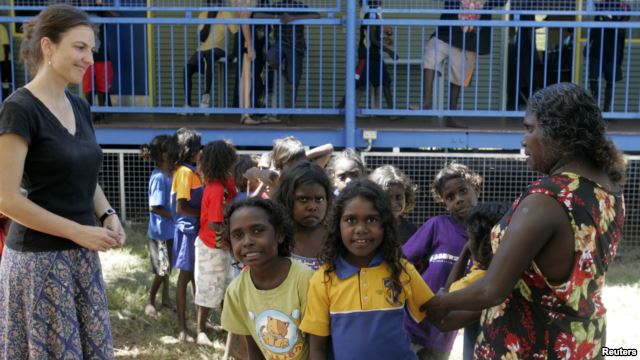VOA慢速英语: 澳大利亚把对原住居民援助和学生上课出勤率联系起来(双语)
- 参考译文
- 听力原文
Australia Links Aboriginal Aid to School Attendance
澳大利亚把对原住居民的援助和上课出勤率联系起来
From VOA's Learning English, this is the Education Report.
这里是美国之音慢速英语教育报道。
Parents in South Australia’s Aboriginal lands may lose some of their financial aid if they do not send their children to school. New rules link school attendance with payments for parents living in poverty.
如果在南澳大利亚的父母不送他们的孩子去上学,那么他们的土地可能会失去一些财政援助。新规定把学校上课出勤率和对贫困家长的补助联系起来。
Warren Mundine is Prime Minister Tony Abbott’s top advisor on issues concerning Aboriginals, native Australians. He disagrees with connecting school attendance and aid. Instead, he urges the government to find ways to improve attendance without punishing parents.
沃伦·穆丁是托尼·阿博特在澳洲原住居民问题上的顶级顾问。他并不赞同将学校上课出勤率和援助联系起来,相反,他敦促政府在不惩罚父母的基础上,来提高学生上课出勤率。
“Now, I know governments find that punitive measures need to happen but I think they’re really a last resort.”
“我知道政府认为现在必须采取惩罚措施,但是我认为这一招应是最后万不得已的手段。”
Mr. Mundine says the situation can change if tribal leaders support education.
穆丁称,如果各部落领袖支持教育,这种情况就可以改善。
“We need to work with parents and we need to work with communities because we are making a massive cultural change here.”
“我们需要同家长合作,同社区合作,因为我们要在这里进行巨大的教育文化改革。”
But other officials say they believe the threat of stopping aid will force families to take education more seriously.
但是其他官员认为,威胁家长要停止援助,会迫使各个家庭更加重视教育问题。
In South Australia state, only fifty percent of children stay in school after the age of fifteen. In some areas, as much as ninety percent of Aboriginal children struggle to read and write.
在南澳大利亚只有50%的孩子在15岁之后继续留在学校上学,在一些地区,90%多的原住居民儿童都难以读和写。
The state government says it has special programs for Aboriginal children. It says students work with their parents and teachers to develop a personal learning plan. The plan is re-examined each year. Local officials also say the public schools provide special workers -- called mentors -- who work individually with Aboriginal students who need extra help.
州政府表示,他们有针对原住居民儿童的特殊项目,学生与父母及老师一起合作,制定学生个人学习计划,该学习计划每年都要进行审查。当地官员还称,公立学校将提供特殊员工——被称为导师,由他们单独帮助那些需要额外帮助的原住居民儿童。
At year seven, Aboriginal students can join a program called Enter for Success. It helps students deal with the change to high school. The program is designed to improve student attendance at school. The students can choose which high school to attend. School officials say students receive support in reaching the goals on their individual learning plans.
在七年级时,原住居民学生可以参加一个被称为成功入学(Enter for Success)的项目,该项目会帮助学生应对高中的变化。该项目旨在提高学生出勤率,学生们可以选择去哪所高中就读。学校官员称,学生会获得实现其个人学习计划的支持。
The state of Western Australia also has special programs for Aboriginal and other ethnic groups. The state operates a program called Focus Schools. The program centers on basic skills like reading, writing and numbers skills. Sixty-seven of these public Focus Schools serve students in 79 very rural areas. Most are primary schools. Some students on the secondary level study with Internet teaching programs. The state’s minister for education and child development said the Focus Schools program also includes 118coaches working with students in 134 schools.
西澳大利亚也有针对原住居民和其他民族的特殊项目,该州管理了一个被称为“重点学校”的项目。该项目主要锻炼学生们的阅读、写作和数字技能等基本技能。有67所这样的公立重点学校服务于79个农村地区,其中多数是小学。一些中学学生通过网络教学进行学习。该州的教育和儿童发展部部长称,重点学校项目还包括了118位在134所学校同学生们一起合作的教练。
About 670,000 indigenous peoples live in Australia.
大约有67万原住居民生活在澳大利亚。
And that's the VOA Learning English Education Report. I'm Catherine Cole.
这就是本期美国之音慢速英语教育报道的全部内容,我是凯瑟琳·科尔。
Australia Links Aboriginal Aid to School Attendance
Parents in South Australia’s Aboriginal lands may lose some of their financial aid if they do not send their children to school. New rules link school attendance with payments for parents living in poverty.
Warren Mundine is Prime Minister Tony Abbott’s top advisor on issues concerning Aboriginals, native Australians. He disagrees with connecting school attendance and aid. Instead, he urges the government to find ways to improve attendance without punishing parents.
“Now, I know governments find that punitive measures need to happen but I think they’re really a last resort.”
Mr. Mundine says the situation can change if tribal leaders support education.
“We need to work with parents and we need to work with communities because we are making a massive cultural change here.”
But other officials say they believe the threat of stopping aid will force families to take education more seriously.
 |
In South Australia state, only fifty percent of children stay in school after the age of fifteen. In some areas, as much as ninety percent of Aboriginal children struggle to read and write.
The state government says it has special programs for Aboriginal children. It says students work with their parents and teachers to develop a personal learning plan. The plan is re-examined each year. Local officials also say the public schools provide special workers -- called mentors -- who work individually with Aboriginal students who need extra help.
At year seven, Aboriginal students can join a program called Enter for Success. It helps students deal with the change to high school. The program is designed to improve student attendance at school. The students can choose which high school to attend. School officials say students receive support in reaching the goals on their individual learning plans.
The state of Western Australia also has special programs for Aboriginal and other ethnic groups. The state operates a program called Focus Schools. The program centers on basic skills like reading, writing and numbers skills. Sixty-seven of these public Focus Schools serve students in 79 very rural areas. Most are primary schools. Some students on the secondary level study with Internet teaching programs. The state’s minister for education and child development said the Focus Schools program also includes 118coaches working with students in 134 schools.
About 670,000 indigenous peoples live in Australia.
I’m Katherine Cole.
This story is based on reports from Correspondent Phil Mercer in Sydney, Australia with additional information from South Australia and Western Australia and the Australian Board of Statistics. Jeri Watson wrote this report for Learning English. Caty Weaver was the editor.
_____________________________________________________________
Words in The News
poverty – n. the condition of being poor
native – n. someone who was born in a place, not who moved there
aborigine - n. a member of the original people to live in an area
Aborigine - n. often capitalized, a member of any of the original, native, peoples of Australia
tribe – n. a group of families ruled by a common chief or leader
extra – ad. more than normal, expected or necessary
choose – v. to decide between two or more
- 频道推荐
- |
- 全站推荐
- 推荐下载
- 网站推荐




















